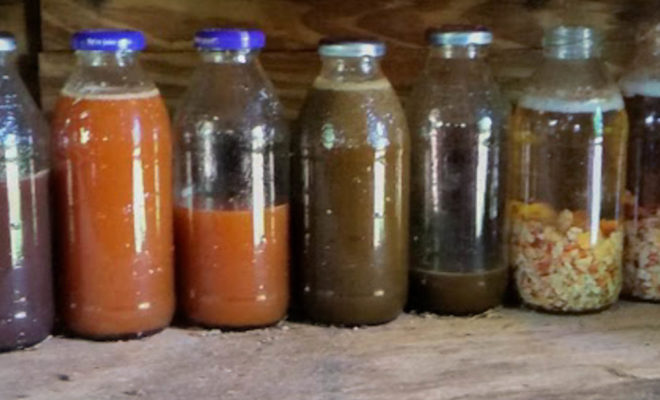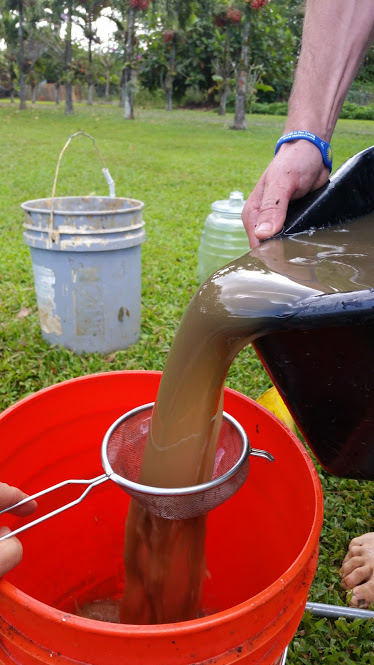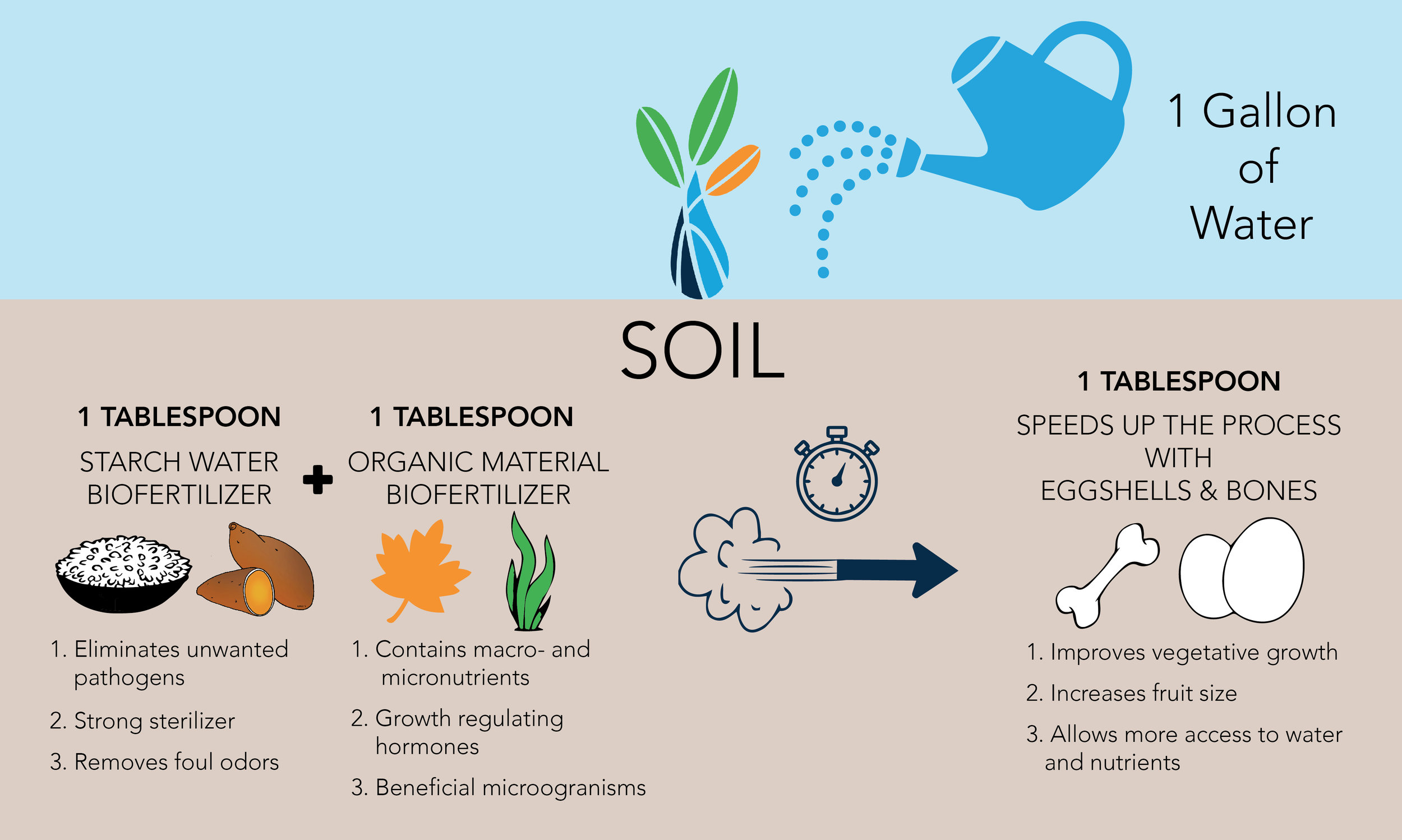Here at the Center for Sustainable Development (CSD), we have been working hard to find the best formula for natural, nutritious fertilizer that we can make ourselves. We have a passion for reducing our community’s waste, and have found the following everyday waste products to make exceptional fertilizer for our gardens and our farm. We have come up with a few ways to make biofertilizer which is an effective, non-polluting and non toxic organic fertilizer. The use of biofertilizer has been shown to improve germination rates, resistance and yield of production crops. Additionally, biofertilizer improves the soil texture and moisture retention of soils. Below, find three different methods for making your own biofertilizer at home.
I. Starch Water Biofertilizer
Fermented Starch Water + Milk + Time = Lactic Acid Bacteria (LAB)
Rice and potatoes may not be the first foods you would think of for making effective fertilizer, but the water you use to wash and cook them works extremely well. This is because it can create lactic acid bacteria, which significantly improves soil health by decomposing any organic matter and reducing any chance of unwanted pathogens associated with decaying material. It will also remove foul odours associated with composting and manure. This starchy water will allow the growth of indigenous bacteria. Milk will be used to isolate the desired bacteria needed for the best fertilizer possible while the unwanted bacteria will die off.
Required Materials:
-
Personal protective equipment
-
Glass jars with lids
-
Rice or potatoes
-
Water
-
Milk
-
Isopropyl alcohol
-
Vinegar
-
Cotton clothes/pillow cases
Make sure to strain all biofertilizers before use.
Steps:
-
Clean and sterilize every glass jar thoroughly with isopropyl alcohol or vinegar.
-
Rinse rice in water for 5 minutes or boil potatoes. Fill a glass jar 2/3 with water from either starch and cover with a cotton cloth and elastic band. The cotton cloth allows for air exchange. Place jar outside under a box. The box stops UV sunlight rays from killing the bacteria growing in the water. Let sit for two days.
-
Take fermented rice or potato wash water and fill 1/10 of new glass jar. Fill the remaining 9/10 of the glass jar with milk. Cover with cotton cloth to allow for air exchange. Place on a shelf with no direct sunlight. Let sit for 5-7 days.
-
Separate liquid from curds. This liquid is called Lactobacillus. Store LAB serum in glass jars with lids tightened. LAB has a 6 month shelf life.
-
Dilute 1 tablespoon LAB serum with 1 gallon of water and apply to soil/compost and plants generously. Apply as needed.
II. Organic Material Biofertilizer (e.g. Seaweed, Leaves, Weeds, Fruits, Vegetables, Manure)
Members of Team CSD collecting seaweed.
The best materials for natural fertilizer can be found in nature itself. Seaweed, leaves, weeds, fruits, vegetables and manure or any other organic material are great for making biofertilizer because they contain macro and micronutrients, growth-regulating hormones and living beneficial microorganisms. Make sure to keep each type of organic material separate when making biofertilizer, however, it is okay to mix the final liquid products together.
Required Materials:
-
Personal protective equipment
-
Plastic bucket
-
Organic material for fermenting (e.g. Seaweed, freshly picked leaves, fruits vegetables and manure)
-
Water
Steps:
-
Collect organic material (e.g. Seaweed, freshly picked leaves, fruits, vegetables and manure).
-
Rinse organic material with fresh water to clean off any debris.
-
Fill a plastic bucket with cleaned organic material.
-
Fill the plastic bucket containing clean organic material with fresh water.
-
Place the lid on the plastic bucket containing organic material and water.
-
Let the contents in the plastic bucket anaerobically ferment (without aerating or mixing) for 4 weeks or longer.
-
Once anaerobic fermentation process is complete, separate the remaining organic material from the nutrient-rich water. Store the nutrient rich water in an airtight jar. One can continue steps 4 through 7 with remaining organic material or acquire new organic material.
-
Dilute nutrient rich water 1 tablespoon with 1 gallon of water and apply to soil generously or spray on plants generously. Apply as needed.
III. Eggshell and Bone Biofertilizer
The chickens we raise on our farm produce over 10,000 eggs a year, and we import even more eggs and meat to satisfy the breakfast, lunch and dinner needs of our students, staff and faculty. We end up with a lot of leftover eggshells and bones! Instead of just throwing these away, we have found that they are the perfect tools to create healthy and nutritious fertilizer.
These leftovers have been shown to improve vegetative growth and increase fruit size while preventing environmental stress and fruit drop. Here at CSD, we have seen that these products enable the plant to access more water and nutrients before and during the reproductive life cycle.
Required Materials:
-
Personal protective equipment
-
Glass jars w/ lids
-
Eggshells & bones
-
Vinegar
Adding vinegar to the eggshells/bones will result in bubbles for up to 48 hours.
Steps:
-
Collect dried eggshells and/or bones and dry them out for as long as possible in the sun or solar kiln before use.
-
Crush eggshells and/or bones with a mallet and fill a clean glass jar ⅔ full with them.
-
Fill the glass jar containing crushed eggshells and/or bones with vinegar and loosely place the lid on top.
-
There will be a reaction – bubbles will rise to the surface (If the glass jar lid is closed tightly the gas build up will break the glass).
-
Allow the reaction to finish (approximately 24-48 hours) before tightening the glass jar lids for storage.
-
Dilute 1 tablespoon nutrient rich vinegar with 1 gallon of water and apply to soil/compost and plants generously. Apply as needed.
——-
To get the best results, use all three of the above biofertilizers. We have found that the combination of 1 tablespoon (strained – no solids) of each biofertilizer with 1 gallon of water is the perfect recipe for healthy and nutritious vegetation.
Happy gardening!







